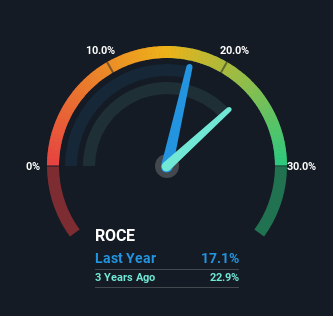Investors Could Be Concerned With BCL Industries' (NSE:BCLIND) Returns On Capital
What are the early trends we should look for to identify a stock that could multiply in value over the long term? Typically, we'll want to notice a trend of growing return on capital employed (ROCE) and alongside that, an expanding base of capital employed. Basically this means that a company has profitable initiatives that it can continue to reinvest in, which is a trait of a compounding machine. Having said that, from a first glance at BCL Industries (NSE:BCLIND) we aren't jumping out of our chairs at how returns are trending, but let's have a deeper look.
Return On Capital Employed (ROCE): What Is It?
Just to clarify if you're unsure, ROCE is a metric for evaluating how much pre-tax income (in percentage terms) a company earns on the capital invested in its business. The formula for this calculation on BCL Industries is:
Return on Capital Employed = Earnings Before Interest and Tax (EBIT) ÷ (Total Assets - Current Liabilities)
0.17 = ₹1.6b ÷ (₹13b - ₹3.5b) (Based on the trailing twelve months to March 2024).
Therefore, BCL Industries has an ROCE of 17%. In absolute terms, that's a satisfactory return, but compared to the Food industry average of 13% it's much better.
Check out our latest analysis for BCL Industries

While the past is not representative of the future, it can be helpful to know how a company has performed historically, which is why we have this chart above. If you're interested in investigating BCL Industries' past further, check out this free graph covering BCL Industries' past earnings, revenue and cash flow.
So How Is BCL Industries' ROCE Trending?
We weren't thrilled with the trend because BCL Industries' ROCE has reduced by 30% over the last five years, while the business employed 238% more capital. However, some of the increase in capital employed could be attributed to the recent capital raising that's been completed prior to their latest reporting period, so keep that in mind when looking at the ROCE decrease. BCL Industries probably hasn't received a full year of earnings yet from the new funds it raised, so these figures should be taken with a grain of salt.
On a related note, BCL Industries has decreased its current liabilities to 27% of total assets. So we could link some of this to the decrease in ROCE. What's more, this can reduce some aspects of risk to the business because now the company's suppliers or short-term creditors are funding less of its operations. Since the business is basically funding more of its operations with it's own money, you could argue this has made the business less efficient at generating ROCE.
The Bottom Line On BCL Industries' ROCE
In summary, despite lower returns in the short term, we're encouraged to see that BCL Industries is reinvesting for growth and has higher sales as a result. And long term investors must be optimistic going forward because the stock has returned a huge 159% to shareholders in the last three years. So should these growth trends continue, we'd be optimistic on the stock going forward.
If you want to know some of the risks facing BCL Industries we've found 3 warning signs (1 doesn't sit too well with us!) that you should be aware of before investing here.
While BCL Industries may not currently earn the highest returns, we've compiled a list of companies that currently earn more than 25% return on equity. Check out this free list here.
Valuation is complex, but we're here to simplify it.
Discover if BCL Industries might be undervalued or overvalued with our detailed analysis, featuring fair value estimates, potential risks, dividends, insider trades, and its financial condition.
Access Free AnalysisHave feedback on this article? Concerned about the content? Get in touch with us directly. Alternatively, email editorial-team (at) simplywallst.com.
This article by Simply Wall St is general in nature. We provide commentary based on historical data and analyst forecasts only using an unbiased methodology and our articles are not intended to be financial advice. It does not constitute a recommendation to buy or sell any stock, and does not take account of your objectives, or your financial situation. We aim to bring you long-term focused analysis driven by fundamental data. Note that our analysis may not factor in the latest price-sensitive company announcements or qualitative material. Simply Wall St has no position in any stocks mentioned.
Have feedback on this article? Concerned about the content? Get in touch with us directly. Alternatively, email editorial-team@simplywallst.com
About NSEI:BCLIND
BCL Industries
An agro-processing and manufacturing company, engages in the edible oil, rice milling, grain-based distillery, and real estate businesses in India.
Adequate balance sheet second-rate dividend payer.
Market Insights
Community Narratives




